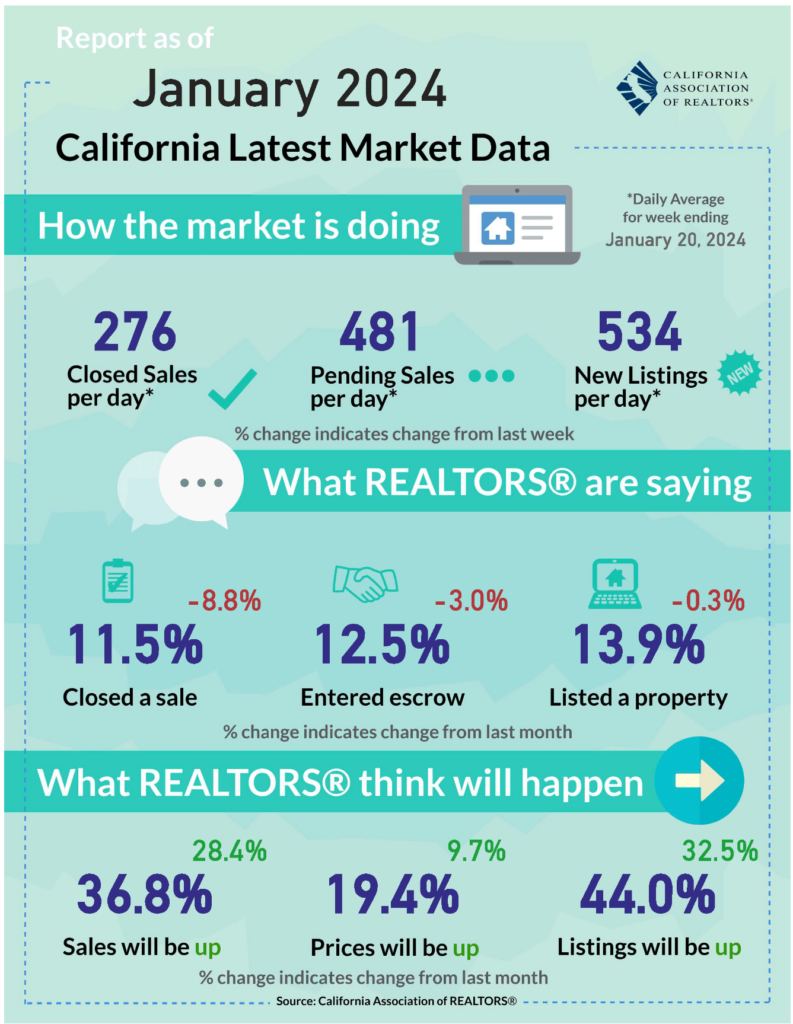Economic & Market Update – January 29, 2024
Southern California Real Estate Market Weekly Snapshot
As we continue through the early stages of 2024, the Southern California real estate market is influenced by a dynamic economic landscape. This week’s key economic indicators provide a snapshot of the current trends and their potential impact on the market:
Economic Growth and Consumer Spending:
- The economy grew at an impressive 3.3% in the fourth quarter, surpassing expectations and largely driven by strong consumer spending.
- The Personal Consumption Expenditures (PCE) index, a measure of inflation, dipped below 3%, marking its lowest level since March 2021.
Stock Market Performance:
- The Dow Jones Industrial Average closed the week at 38,109.43, up 0.6% from 37,863.80 last week, and showing a 1.1% increase year-to-date.
- The S&P 500 ended the week at 4,890.97, a 1% rise from 4,839.81 last week, and up 2.5% since the beginning of the year.
- The Nasdaq closed at 15,455.36, up 1% from 15,310.97 last week, marking a 3% increase year-to-date.
Bond Yields and Mortgage Rates:
- The 10-year treasury bond yield remained stable at 4.15%, unchanged from the previous week.
- The 30-year treasury bond yield ended the week at 4.38%, almost unchanged from 4.36% last week.
- Mortgage rates, as reported by Freddie Mac, showed an increase with the 30-year fixed mortgage rate at 6.69%, up from 6.60% last week, and the 15-year fixed at 5.95%, up from 5.76% last week.
These indicators, from the robust economic growth to the rising mortgage rates, play a crucial role in shaping the real estate market in Southern California. The strong stock market performance reflects investor confidence, while the stable bond yields and increasing mortgage rates could influence buyer decisions in the housing market.
In the following sections, we will delve deeper into how these economic factors are impacting the real estate market, from housing demand and pricing trends to future market projections.
In-Depth Analysis of the Southern California Real Estate Market
Impact of Economic Growth and Consumer Spending
- Strong Economic Growth: The 3.3% growth in the economy, primarily fueled by consumer spending, suggests a robust economic backdrop for the real estate market. This level of growth typically boosts consumer confidence and spending power, which can translate into increased real estate activity.
- Inflation Trends: The dip in the PCE index below 3% indicates a cooling inflation scenario. This moderation in inflation could lead to more stable and predictable costs for real estate investments.
Stock Market Performance and Real Estate
- Investor Confidence: The record highs in the S&P 500 and the Dow Jones Industrial Average reflect strong investor confidence. This confidence can spill over into the real estate market, as investors often look for tangible assets like property in times of stock market prosperity.
- Economic Indicators: The stock market’s performance is often a leading indicator of economic health, which in turn influences the real estate market. A strong stock market typically correlates with a healthy real estate market.
Bond Yields, Mortgage Rates, and Housing Affordability
- Stable Bond Yields: The stability in the 10-year and 30-year treasury bond yields is crucial for mortgage rate predictions. Stable or declining bond yields can lead to lower mortgage rates, which can boost the housing market.
- Rising Mortgage Rates: The increase in mortgage rates, as reported by Freddie Mac, could impact housing affordability. Higher mortgage rates mean higher monthly payments for new homebuyers, which could dampen demand in the housing market.
Housing Market Trends in Southern California
- Sales and Inventory: The real estate market in Southern California has been experiencing a downturn in home sales, partly due to high borrowing costs and tight supply. However, some counties are showing an increase in new listings, which could help alleviate the inventory crunch.
- Price Trends: Despite the challenges, home prices have maintained an upward trajectory due to the tight supply. This trend is likely to continue, especially if the supply remains limited and demand stabilizes or increases.
Future Outlook
- Economic and Market Predictions: The combination of strong economic growth, cooling inflation, and the potential for interest rate stabilization presents a mixed but cautiously optimistic outlook for the Southern California real estate market.
- Market Dynamics: Buyers might face challenges with higher mortgage rates, but the strong economic fundamentals could encourage more people to enter the market. Sellers might benefit from continued price appreciation due to limited supply.
- Regional Variations: Different areas in Southern California might experience varying market conditions. Areas with more new listings and construction activity might see more dynamic market conditions compared to areas with tighter inventory.
Conclusion: Navigating a Dynamic Market
The Southern California real estate market in early 2024 is navigating through a period of economic strength, fluctuating mortgage rates, and evolving market dynamics. While the market faces challenges from rising mortgage rates and tight inventory, the strong economic indicators and consumer confidence provide reasons for optimism. Stakeholders in the real estate market, including buyers, sellers, and investors, should closely monitor these economic trends and be prepared to adapt to the changing market conditions. The key to success in this dynamic market will be staying informed and responsive to the evolving economic landscape.




